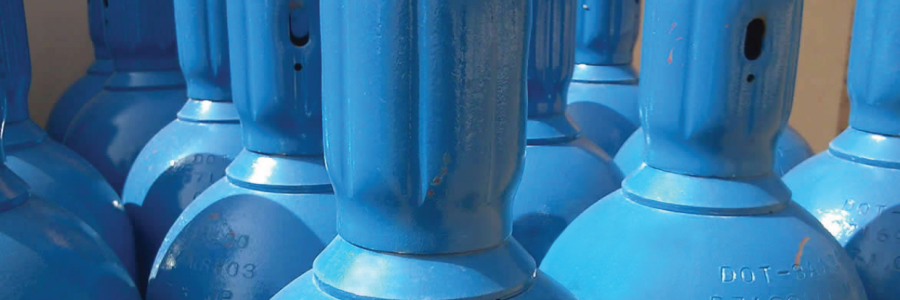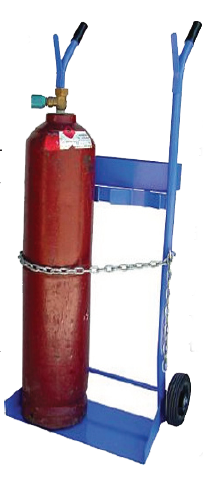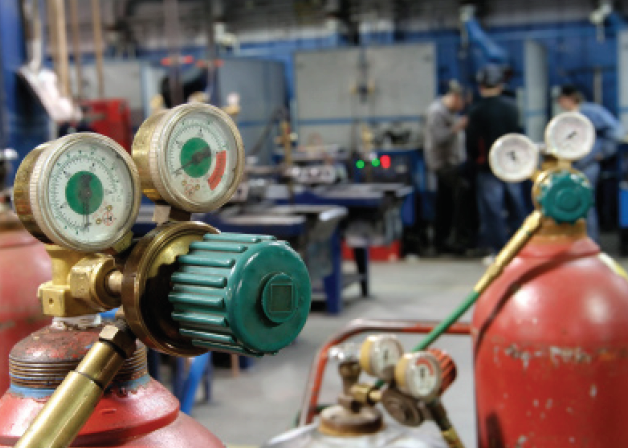
Compressed Gas Cylinder Safety
Compressed gases pose a unique hazard. Depending on the particular and mechanical hazards associated with high pressure as well as chemical hazards associated with the gas itself. As a result, gas cylinders require special storage and handling precautions. Compressed gas and equipment is addressed in specific OSHA standards for both general industry and the construction industry among others. Other relevant standards are established by the Compressed Gas Association (CGA) which is dedicated to the development and promotion of safety standards and safe practices in the industrial gas industry.
ASSOCIATED HAZARDS
There are hundreds of different types of materials that may be stored in a compressed gas cylinder including oxygen, fuel, refrigerants, inert gases, and poison gases among others. The compressed gasses used most commonly are acetylene and oxygen. Acetylene is highly flammable. Although oxygen is not a flammable gas, it supports combustion by making fires burn more intensely. Oxygen, as well as acetylene and other compressed gases, if released suddenly, can cause a cylinder to become a missile-like projectile.
PROPER STORAGE AND HANDLING
Serious accidents may result from the misuse or mishandling of compressed gas cylinders and only trained employees should be assigned to handle cylinders under pressure.
 Acetylene cylinders must be separated from incompatible cylinders. Flammable cylinders must be segregated from oxygen cylinders by at least 20 feet when not in use or by a five-foot high partition with at least a one-half hour fire rating, according to OSHA standards. The cylinders should be stored with the valve end up and this is especially true for acetylene.
Acetylene cylinders must be separated from incompatible cylinders. Flammable cylinders must be segregated from oxygen cylinders by at least 20 feet when not in use or by a five-foot high partition with at least a one-half hour fire rating, according to OSHA standards. The cylinders should be stored with the valve end up and this is especially true for acetylene.
Chains or other restraints should also be used to prevent cylinders from falling or being knocked over.
The storage area should be dry, and well-ventilated, as leaks may cause oxygen to be displaced, a flammable atmosphere, or a toxic environment depending on the contents of the cylinder. Cylinders are not designed for temperatures in excess of 130 °F so they should not be stored near sources of heat such as radiators or furnaces. Acetylene storage rooms should have no other occupancy and not contain any oxidizing agents or sources of ignition. Fire extinguishers should be readily available throughout the storage area, and, of course, no smoking should be permitted. Oxygen cylinders should not be stored near combustible or flammable products including hydrocarbon fuels or petroleum products.
Always consider cylinders as full and handle and store them with appropriate care. Accidents have happened when containers under partial pressure were thought to be empty. If the contents are emptied, the valve should not be left open, as contaminants can get inside the cylinder. Instead, positive pressure should be maintained inside the cylinder to prevent contaminants from entering the cylinder.
Because of their shape, smooth surface and weight, cylinders are difficult to carry by hand but they must never be rolled or dragged. They should be transported on a hand or motorized truck and secured to keep them from falling. When they must be transported longer distances, the cylinders should be properly secured with special attention paid to protecting the valve stem from damage and valve protection caps are should be in place during storage and transport. Do not lift cylinders by the cap and do not transport them with the regulator attached. They should not be lifted using magnetic devices. Where cylinders must be handled by a crane or derrick, they should be carried in a cradle or suitable platform and extreme care taken to not drop or bump them.
USING CYLINDERS SAFELY
The training requirements for gas cylinder usage fall under OSHA’s hazard communication training requirements and as such, it is essential to know and understand the properties, uses, and safety precautions of the gas before using the cylinder. This will also ensure the appropriate Material Safety Data Sheet (MSDS) is nearby.
Always use the proper regulator for the gas in the cylinder and check the regulator before attaching it to a cylinder. If the connections do not fit together, the wrong regulator is being used. Regulators are threaded differently by type and standardized by the CGA to prevent accidents. Do not use lubricants or allow oil or grease to come in contact with the cylinder or their valves as they may be incompatible with the cylinder contents.
Attach the regulator securely before opening the cylinder valve and always use a cylinder wrench to tighten the regulator nut and hose connection. Open cylinder valves slowly. A cylinder without a hand wheel valve should be opened only with a tool provided or approved by the gas supplier.
Before making a connection to a cylinder valve outlet, crack the valve for an instant to clear the opening of any debris, then adjust the pressure. Do not open an acetylene valve all the way, just a quarter turn in case you have to turn off the fuel source quickly in case of a fire. Oxygen valves, on the other hand, should be opened all the way because there is a back-seating valve on the oxygen cylinder that prevent the high-pressure gas from leaking out through the threaded stem. Open the valves from side.
Always point the valve and opening away from the body and away from anyone else in case there is a failure to the regulator, which may cause the valve stem on the regulator to fail and blow out. Always ensure the cylinder is set to the correct pressure indicated for that gas. If you are using the right regulator, there should be indicators on the gauge with an operation range with indicator where the pressure should be set. Acetylene is not stable above a gauge pressure of 15 pounds per square inch (psig) and the gauge pressure must be kept below this setting.
Before a regulator is removed from a cylinder valve, close the cylinder valve and release the gas from the regulator. Cylinder valves should be closed, when work is finished, even if the contents are empty.
LEAK PROCEDURES
Always inspect cylinders, regulators, and hoses before use. If you suspect a leak, you can lightly spray a soap and water solution around the fittings, hoses, and other suspect leak area. If the area “bubbles up,” a leak is present. Cylinders, regulators, hoses, and/ or fittings that develop leaks should be removed from service and properly tagged. Cylinders that develop leaks should be moved to a well-ventilated area and the supplier notified.
OTHER SAFETY PRECAUTIONS
Never use oxygen in place of compressed air in pneumatic tools, oil preheating burners or to start internal combustion engines. Compressed air or oxygen or any compressed gas should also not be used to blow off clothing. Articles can become airborne and strike the eye or oxygen can be injected into a cut or injury introducing air bubbles into the bloodstream. Oxygen saturated clothing can become a torch if contact is made with a lit cigarette or an accidental spark.
Finally, respect the high pressure of compressed gas cylinders. A sudden release of pressure, such as from damage or failure to the valve stem can gain enough momentum to break through a cinderblock wall 200 feet away.

Share This Article!


